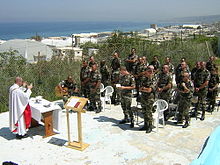Field service


Under Feldgottesdienst ( Roman Catholic and Field Mass ) refers to a celebrated open-air church service . The name comes from the military, where masses were celebrated in the field , so today the services celebrated by civil parishes in the open air (for example on Ascension Day or at rifle festivals ) are referred to as field services.
history
Military services in garrison churches have existed since the 19th century with the emergence of their own military churches.
Field services have been an integral part of troop celebrations during a war since the early 19th century. They are documented for the German-Danish War (1864) and the German-French War 1870–1871. At that time there were not only Christian but also Jewish field services, for example on the highest Jewish festival, Yom Kippur .
During the First World War , such services, especially when they were celebrated in trenches or at Christmas , were often formative experiences for the mostly young participants. "Field services were part of everyday life for soldiers of the Christian denominations as well as the Jewish religion."
As part of a field service, the deceased Reich President Paul von Hindenburg was buried in the Tannenberg Memorial on October 2, 1935 . While the National Socialists took numerous opportunities for field services at the beginning of their rule, this attitude changed during the Second World War . Hermann Göring, as Commander-in-Chief of the Air Force , decreed on April 13, 1940, “Field services should only be held if there was a demand that there was a need. For the soldiers who do not take part in the field service, no service is to be scheduled during this time. "
A peculiarity of field services was that in times of war they were held for a certain unit ( regiment , division or army corps ) without denominational separation , often in cooperation between the Catholic and the Protestant field chaplain . During the war, military services were often held in the respective local churches of the occupied hinterland .
During World War II allowed the field bishop of the Wehrmacht Catholic priests in Masses instead of the liturgically prescribed altar stone with inserted holy relics a textile "Antimensium" with sewn relics as a base for the chalice and paten to use. This applied to field services with the troops as well as to private celebrations by individual soldiers who were priests.
Situation in the military chaplaincy today

The soldiers who attend the service usually stand in a rectangle in front of the altar , while musicians or other contributors stand in a semicircle behind the altar. It is battle dress worn, and the chaplain carries this. Often, field services are held as a pure word service . If it arises, this service is ecumenical and is aimed at soldiers of all denominations . It can be held by a Catholic and / or Protestant military chaplain. The soldiers' prayer book, which contains songs and prayers, is used for this purpose. The chaplain celebrates the service, while the drum music accompanies the event at the beginning, after the blessing and at the end. If there are a larger number of participants, a music corps takes over the musical framework and thus represents the organ . The altar is portable and usually made of wood ; he is provided with an altar cloth without further (flower) decorations with the necessary liturgical implements and books.
If a Catholic mass is held, the proper law of canon law over the sacraments must be observed. The Catholic military bishop may generally allow field services in military facilities; if they take place outside, he must ask the respective local bishop for permission. In a Catholic mass, soldiers usually perform the function of acolytes without special clothing. The celebrant wears a stole in the liturgical color over his field suit .
Web links
Individual evidence
- ↑ Graf Löwenbalk Hohenthal: Complete history of the Franco-German war from 1870–71 . Robert Schaefer's Verlag, Leipzig / Berlin 1871, pp. 549, 552.
- ↑ "Aren't we brothers?" German Jews in the National War 1870/71 (= War in History, Volume 31). Schöningh, Paderborn 2006, ISBN 3-506-75648-6 , pp. 117-129.
- ^ Heidrun Alzheimer-Haller: War as a matter of faith . Religious motifs on picture postcards from the First World War. Ed. Franconian Open Air Museum, 2009, p. 19.
- ↑ The archive . Reference book for politics, economics, culture. Issues 19-21 (1936), p. 965.
- ^ Rudolf Absolon: The Wehrmacht in the Third Reich . Volume 16, Issue 5 (= publications of the Federal Archives, Volume 16). H. Boldt, 1988, ISBN 3-7646-1874-4 , p. 290.
- ↑ Friedrich Altrichter: The reserve officer, a manual for the officer and officer candidate for the leave status of all weapons . Mittler, 1940, p. 133.
- ↑ Monica Sinderhauf: Antimensium . ( Memento of the original from March 25, 2016 in the Internet Archive ) Info: The archive link was inserted automatically and has not yet been checked. Please check the original and archive link according to the instructions and then remove this notice. catholic-militaerseelsorge.de, accessed on February 22, 2017.
- ↑ Field service . In: Meyers Großes Konversations-Lexikon . 6th edition. Volume 6, Bibliographisches Institut, Leipzig / Vienna 1906, p. 397 .
- ↑ Papal statutes for the area of jurisdiction of the Catholic military bishop for the German Armed Forces , Art. 25.
